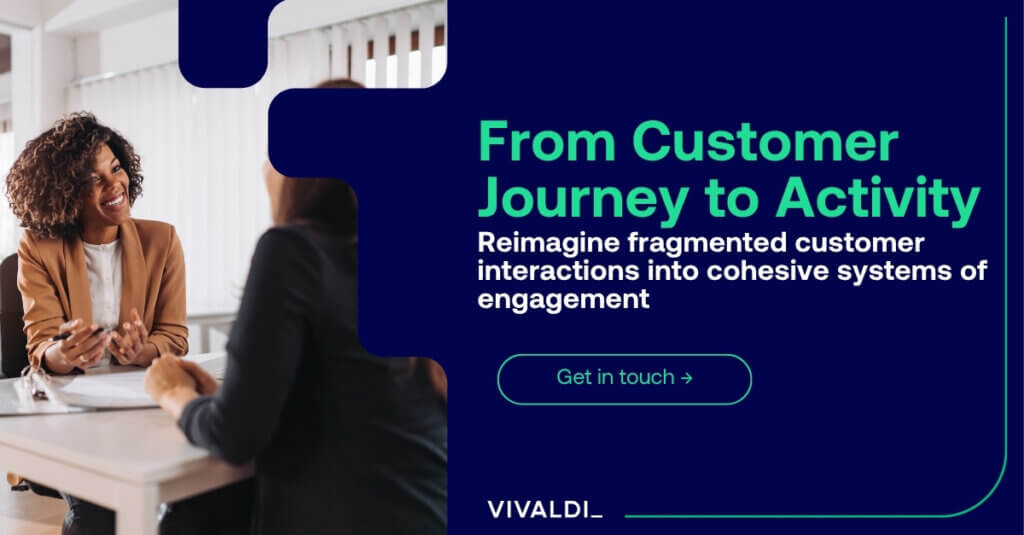The Power of a Customer Ecosystem Strategy for Modern Business
A well-architected customer ecosystem strategy and interaction field design consulting services model is no longer a competitive luxury—it’s a strategic imperative. Vivaldi enables companies to structure and scale ecosystems that engage customers, elevate interactions, and drive exponential business growth.
Our approach is rooted in designing interaction fields—dynamic environments where participants from across the value chain co-create shared value. By aligning customer experience strategy with broader business goals, Vivaldi builds platforms that generate not just transactions, but lasting relationships.
Transforming Customer Experience for Long-Term Growth
Vivaldi understands that customer experience goes beyond individual touchpoints. It’s about creating connected, memorable experiences that deliver real value to customers. Through ecosystem orchestration, we help our clients turn fragmented journeys into seamless narratives.
Explore our customer experience strategy services to see how we link human emotion with systemic transformation.
Driving Engagement Through Ecosystem-Centric Design
Sustained customer engagement requires more than just campaigns or loyalty programs. Vivaldi designs environments that fuel personalized interactions, where every engagement increases relevance, value, and satisfaction.
Our team maps the interdependencies across ecosystems to identify where engagement can deepen relationships and strengthen community—turning passive consumers into active co-creators.
Mapping the End-to-End Customer Journey with Precision
Your customer journey is complex—and often invisible. Vivaldi’s approach to journey mapping goes deeper, leveraging behavioral and emotional insights to uncover pain points and opportunity zones across every stage of the experience lifecycle.
From acquisition to advocacy, we build customer journey models that illuminate how, when, and why customers interact, so businesses can act with intent.
Redefining Customer Experience Consulting with a Strategic Lens
Our customer experience consulting model is uniquely strategic. Vivaldi integrates customer insight, market dynamics, and brand positioning to guide experience innovation and ecosystem design.
Unlike traditional firms, we go beyond diagnosing problems—we build tailored strategies that align experience with brand and business ambition.
Creating Value Through Better Customer Satisfaction
At Vivaldi, we measure success not just in sales—but in customer satisfaction. We believe that improved satisfaction is a leading indicator of brand equity and future growth.
By addressing unmet customer needs and expectations through ecosystem thinking, we elevate customer interaction quality and loyalty. That leads to both short-term wins and sustained competitive advantage.
Unlocking Business Growth with Ecosystem Models
Our work isn’t hypothetical. Ecosystems create real-world impact. Vivaldi enables brands to move from isolated transactions to business growth powered by customer-centric, data-enabled collaboration.
Whether you’re launching a new platform, optimizing your go-to-market, or evolving your experience model—Vivaldi’s strategic and growth innovation capabilities deliver transformative results.
From Consumer Insights to Experience Activation
Effective ecosystems begin with consumer insights. Our teams uncover the underlying motivations and pain points that shape decision-making and customer behavior. These insights power smarter decision making, innovation, and design of brand-led ecosystems.
Learn how our research & insights capabilities fuel strategies that resonate at the right depth and scale.
Human Centered by Design, Not as an Afterthought
Human truths sit at the heart of every Vivaldi strategy. We embed human centered thinking into every engagement—fusing empathy with analytics, and creativity with business logic.
Our frameworks reveal the emotional and behavioral nuances of the customers you’re trying to serve, allowing us to design systems that feel intuitive, engaging, and purpose-built.
Elevating Experience Strategy from Tactic to Transformation
We don’t treat experience strategy as a functional layer—we view it as a core strategic pillar. Vivaldi connects brand purpose, business objectives, and technology to engineer ecosystem experiences that are adaptive, personalized, and measurable.
See how our experience strategy services reframe value creation through the lens of modern interactions.
Designing Intelligent Interaction Fields for Lasting Value
At the core of every ecosystem is an interaction field—a vibrant network where customers, partners, and even competitors contribute to collective value. Vivaldi’s interaction field modelling services guide companies through the creation and governance of these powerful structures.
By increasing the quantity and quality of customer interaction, Vivaldi enables network effects, data learning loops, and continuous experience refinement.
Achieving Competitive Advantage Through Connected Experiences
Vivaldi turns experience design into a lever for competitive advantage. We align platforms, products, and services to ecosystem logic—ensuring that every component drives deeper connection, higher loyalty, and scalable differentiation.
Our digital ecosystem design services bring together strategy, experience, and technology for maximum impact.
Empowering Companies with Data-Driven Customer Centricity
We help companies embed customer centricity into the DNA of their business. From reorganizing around customer journeys to creating services that respond to shifting customer needs, our strategies are powered by data and grounded in value creation.
Vivaldi’s ecosystem models enable business operations to become more agile, responsive, and insight-driven.
Creating New Services and Experiences That Resonate
Vivaldi doesn’t just optimize what exists—we help clients create experiences and platforms that reimagine what’s possible. Our new business model work focuses on identifying white spaces and designing solutions that unlock new customers, revenue streams, and market positions.
Whether you’re modernizing your customer relationship management approach or launching a new platform, our experts guide every step.
Experience Consulting That Translates to Real Business Impact
Too often, experience consulting stops at PowerPoint. At Vivaldi, our frameworks are designed to move directly into activation. We co-create with clients to implement scalable, systemized solutions.
From brand strategy to customer engagement design, we align every strategy with executional clarity.
The Future of Customer Experience Is Interaction-Driven
In a world where expectations evolve daily, static experiences fail. Vivaldi helps brands future-proof their customer ecosystems through adaptable interaction field designs.
Backed by our AI-powered tools and generative AI applications, we enable companies to build smarter experiences that learn, adapt, and deliver lasting value.
Ready to Design Your Ecosystem? Let’s Connect
Vivaldi partners with visionary brands to unlock the power of customer ecosystems and interaction design. Let’s co-create systems that move your business forward and position your brand for what comes next.
Visit our Contact page to start a conversation with our global team. How will your business lead the experience transformation?







